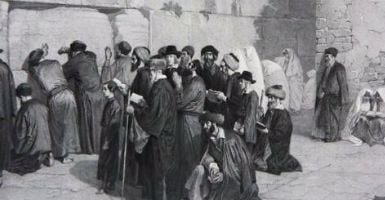R’ Shimon says: A Talmid Chacham is not permitted to benefit from any Seuda which is not for a mitzvah. [To what does this refer?] R’ Yochanan said: Such as [the marriage of] the daughter of a Kohen to a Yisrael or the daughter of a Talmid Chacham to an Am haAretz, as R’ Yochanan said: [The marriage of] the daughter of a Kohen to a Yisrael will not result favorably. In what way? R’ Chisda said: Either [she will become] a widow or divorcee, or she will not have children. It was taught in a B’raisa: Either he will bury her or she will bury him, or she will bring him to poverty. Is that so? Surely R’ Yochanan said: One who wants to become wealthy should attach himself to the seed of Aharon – [certainly] the Torah and Kehuna will make them wealthy. This is not a question as [the latter statement] refers to a Talmid Chacham, whereas this [the latter statement] refers to an Am haAretz. R’ Yehoshua married a Kohenes and he became ill. He said: It is not agreeable to Aharon that I attach myself to his progeny [and] that he has a son-in-law like me. R’ Idi bar Avin married a Kohenes and begot two sons who received Semicha – Rav Sheshes bar R’ Idi and Rav Yehoshua bar R’ Idi. R’ Pappa said: If I had not married a Kohenes, I would not have become wealthy. R’ Kahana said: If I had not married a Kohenes I would not have gone into exile. They said to him: But you were exiled to a place of Torah! [He replied:] I was not exiled as people are exiled (others exile themselves to a place of Torah of their own volition, I had no choice). (Pesachim 49a)
This passage of Gemara clearly indicates that the marriage of an Am haAretz to a Bas Kohen is not agreeable and may pose a Sakana – the husband may die, divorce his wife, or be poverty-stricken.
[The Ben Yehoyada[1] (ad. loc.) adds that an allusion to this can be found by combining and rearranging the letters of Yisrael and Kohen together to spell “Nishar Kliya – Destruction will remain”.]What is the reason for this Sakana? Rashi explains that a Bas Kohen, “needs to marry Kohanim and not spoil her family by marrying a Yisrael”. Why is there a difference between marrying a Talmid Chacham and an Am haAretz? Rashi also explains: “If he is a Talmid Chacham it is a pride for him [Aharon], but if he is an Am haAretz and not a Kohen, it is a “Genai” (disgrace) for Aharon – and they will be punished.”
Rashi implies that there are two elements: First, a Bas Kohen should marry a Kohen. (See also the Ran on the Rif who makes this point.) Second, that if she marries a Yisrael, her ancestor Aharon may take umbrage if the Yisrael is unworthy of marrying his descendant.
The Rambam implies otherwise (Hilchos Isurei Bi’ah 21:31):
A Yisrael Am haAretz should not marry a Kohenes because it is a desecration of the Zera Aharon. If he does marry her, the Chachamim have stated that their marriage will not result favorably; rather, he will die without children, he or she will die quickly, or there will be arguments between them. However, a Talmid Chacham who marries a Kohenes – this is pleasing and praiseworthy – Torah and Kehuna together.
In other words, there is no problem with a Bas Kohen marrying a Yisrael – unless he is an Am haAretz.
The difference between Rashi and the Rambam manifests itself in a case when a Bas Kohen has two potential matches: a Kohen who is a Talmid Chacham and a Yisrael who is a Talmid Chacham. It seems that Rashi and the Ran would advise her to choose the Kohen, whereas the Rambam would say that she may choose either.
The “disgrace” mentioned by Rashi (or “Chillul” mentioned by the Rambam) likely refers to the fact that by marrying a Yisrael, a Bas Kohen loses her priestly status (though, according to the Rambam, this is apparently not a problem if she marries a Talmid Chacham). If so, there would seemingly be no issue with a Kohen marrying a Bas Yisrael as neither he nor his children lose their status as Kohanim. However, Rashi in Yevamos (84b) clearly states otherwise:
A Kohen should not marry a Bas Yisrael all the while that he can find a Bas Kohen to marry.
Rashi cites the aforementioned Gemara in Pesachim as a source for this assertion. The Ritva (ibid.) similarly states that it is “Min haMuvchar” (ideal) for a Kohen to marry a Bas Kohen and not a Bas Yisrael. The Rambam, by contrast, makes no mention of this.
Perhaps Rashi and the Rambam’s respective choice of terms help explain the difference. Rashi writes that a Bas Kohen who marries a Yisrael has an element of “Pegam Mishpacha” (familial flaw or defect) while the Rambam describes it as “akin to Chillul” (desecration). The difference is that according to Rashi, when a Bas Kohen chooses to marry a Yisrael it appears to be a statement that there is nobody worthy of marriage from among the progeny of Aharon, thus disgracing the family.[2] This is equally applicable when a Kohen marries a Bas Yisrael.
However, according to the Rambam, the issue is only “Chillul”, meaning the desecration of the Bas Kohen’s priestly status.[3] This does not apply in the reverse scenario when a Kohen marries a Bas Yisrael.
The Shulchan Aruch (E.H. 2:8) thus codifies the Gemara’s ruling:
An Am haAretz should not marry a Kohenes. If he does marry [her], their marriage will lead to unfavorable outcomes: he or she will die quickly or disagreements will arise between them. But a Talmid Chacham may marry a Kohenes; it is pleasing and praiseworthy as Torah and Kehuna [are] in one place.
This ruling (based on the Rambam above) delineates an Issur for an Am haAretz to marry a Kohenes. This goes further than the Gemara that states only that the marriage does not constitute a Seudas Mitzva and that it will lead to unfavorable outcomes.
In spite of this, almost nobody treats this issue as a matter of concern. In fact, this already began in the era of the Rishonim. For example, the Rivash (15, cited by the Beis Yosef E.H. 154) states the following in this regard (as well as concerning other marriages not approved by Chaza”l):
If Beis Din would enforce the letter of the law regarding marriage and force [them to dissolve] they would need to force them all! … Therefore, the Chachmei haDoros turned a blind eye towards [these sorts of] marriages, not acting to prevent them, and certainly not to separate them, as long as both are willing partners and their marriage does not constitute an Ervah or Issur Kedusha.
In other words, it would be ideal to prevent such marriages but this cannot be implemented in practice. Therefore, Batei Din focus on preventing marriages that actually violate full-fledged Issurim.
Obviously, the fact that the Poskim cannot implement a ban on these marriages does not make them permissible. Therefore, the reason we do not treat them as a matter of concern needs explanation. Why does this not violate an Isur Chachamim and why are we not concerned about the Sakana described by the Gemara?
First, we must consider whom the Gemara considers to be an “Am haAretz” (who may not marry a Bas Kohen).
The Chavos Yair (70) states in passing, “We do not have the Am haAretz mentioned by the Chachamim here”.[4] The Mishna Berura accepts this ruling (415:2) but cautions that this is only true if the person in question does not demean the Mitzvos, for if he does, “he is no better than the Am haAretz mentioned in Shas”. In Sha’ar haTziyun (6) he adds that if two people of this nature marry, it is not a Seudas Mitzva, “for it is a Mitzva to distance oneself from people like that so that one does not learn from their deeds. Certainly, one is not to approach to celebrate in their Simcha”.
The Aruch haShulchan makes a similar ruling (E.H. 2:5):
Who is considered an Am haAretz in this regard? One who demeans the Mitzvos, not one who observes Mitzvos, even though he is not a Talmid Chacham. Therefore, there is an opinion that we do not have an Am haAretz now.
We must point out that the Gemara does not appear to support the definition of the Mishna Berura and Aruch haShulchan, for it implies that there are two possibilities – an Am haAretz for whom marriage to a Bas Kohen is wrong, and a Talmid Chacham for whom it is right. According to the Mishna Berura and Aruch haShulchan, the Gemara should have stated that it is wrong for an Am haAretz, and right for one who is not an Am haAretz, even though he is not a Talmid Chacham.
Similarly, according to Rashi and the Ran, there is always a problem with a Bas Kohen marrying a Yisrael and it is only when the Yisrael is a Talmid Chacham that it “compensates” for the problem. If so, how can a person who is not an Am haAretz but isn’t a Talmid Chacham be permitted to marry a Bas Kohen?
This reading of the Gemara does not appear in the Poskim except for a Teshuva of the Maharam Shik (E.H. 6). He discusses whether it is correct for a Talmid Chacham to marry a Bas Kohen given that the Shulchan Aruch (Y.D. 243:2) and Shach (ibid. 18:29) rule that the status of Talmid Chacham is not applicable today (particularly, concerning young men of marriageable age). On the other hand, according to the Magen Avraham (201:24), we don’t have Kohanim Meyuchasim (with verified or established lineage) today. If so, perhaps we should not act stringently in this matter.
The Maharam Shik concludes that although the status of Talmid Chacham does not apply today, he is certainly not to be considered an Am haAretz. (He may, at the very least, be considered a “Tzurba me’Rabanan”, as evident from the Shevus Yaakov 1:144.) Therefore:
Since he is not considered an Am haAretz, he has no Isur to marry a Kohenes. In fact, it would seem that there is the same benefit as there would be for a Talmid Chacham in this instance… it seems that an extraordinary Bachur, and fearer of Heaven, may certainly marry a Kohenes. Their marriage will result well and be blessed, as is stated there regarding a Talmid Chacham.
The Maharam Shik bases his conclusion on the Halacha (Y.D. 251) that a Mamzer Talmid Chacham takes precedence over a Kohen Gadol Am haAretz. This Halacha still applies today, as evident from the Shach (ibid.) The status of Talmid Chacham concerning Kehuna still applies today; it is sufficient to be an exemplary scholar, even if the status of Talmid Chacham no longer exists. The Maharam Shik clearly considered these arguments to be sufficient not only to avoid the Issur but also the Sakana.
He then adds:
There also seems to me to be another reason to permit it considering the reasoning. Rashi in Pesachim 49 states that it is a disgrace for Aharon for his progeny to attach itself to a Yisrael Am haAretz. But a Ben Torah – even while he is young – if he is exemplary and fears Heaven, we are obligated to honor him, as stated in Yoreh De’ah 244… assumedly this Mitzva still applies today… Since we are obligated to honor him, certainly it is no disgrace for Aharon; on the contrary, he would consider it an honor.
What about the question raised by the Sho’el as to whether Kohanim today are Meyuchasim? The Maharam Shik notes that the Pischei Teshuva (322:3) cites many Poskim who disagree with the Maharashdam, who asserted that Kohanim are no longer Meyuchasim. Aside from monetary matters, we do consider Kohanim to be Meyuchasim.
However, this is not the view of the Ben Yehoyada:
Know that these harsh matters that are held by the B’raisa and R’ Chisda were only said of the times of the Tana’im and Amora’im who had Kohanim Meyuchasim and Amei Aratzos of their time who were evil and sinful… But today, we have no Kohanim with Yichus – all are Kohanim based only on a Chazaka… we also do not find Amei Aratzos today who were like those of their times. Therefore, when a Bas Kohen marries a Yisrael or the daughter of a Talmid Chacham marries an Am haAretz, these harsh matters will not transpire. Nevertheless, it is good to be careful about this matter.
In the next essay, we will quote several more Poskim on this subject, and outline Halacha l’Ma’aseh and the Minhag today.
[1] R’ Yosef Chaim of Baghdad (1835-1909), famously known as the Ben Ish Chai.
[2] There are several other instances in which “Pegam Mishpacha” refers to disgracing the family. See Kesubos 84a and Kiddushin 18a.
[3] Somewhat akin to the Chillul created by a Kohen marrying a divorcee.
[4] The Chavos Yair makes this assertion in the context of an Am haAretz marrying the daughter of a Talmid Chacham. However, the Mishna Berura (415:2) maintains that he also refers to the Halacha of an Am haAretz marrying a Bas Kohen. This appears to be based on the Pischei Teshuva (E.H. 2:9).















Add comment